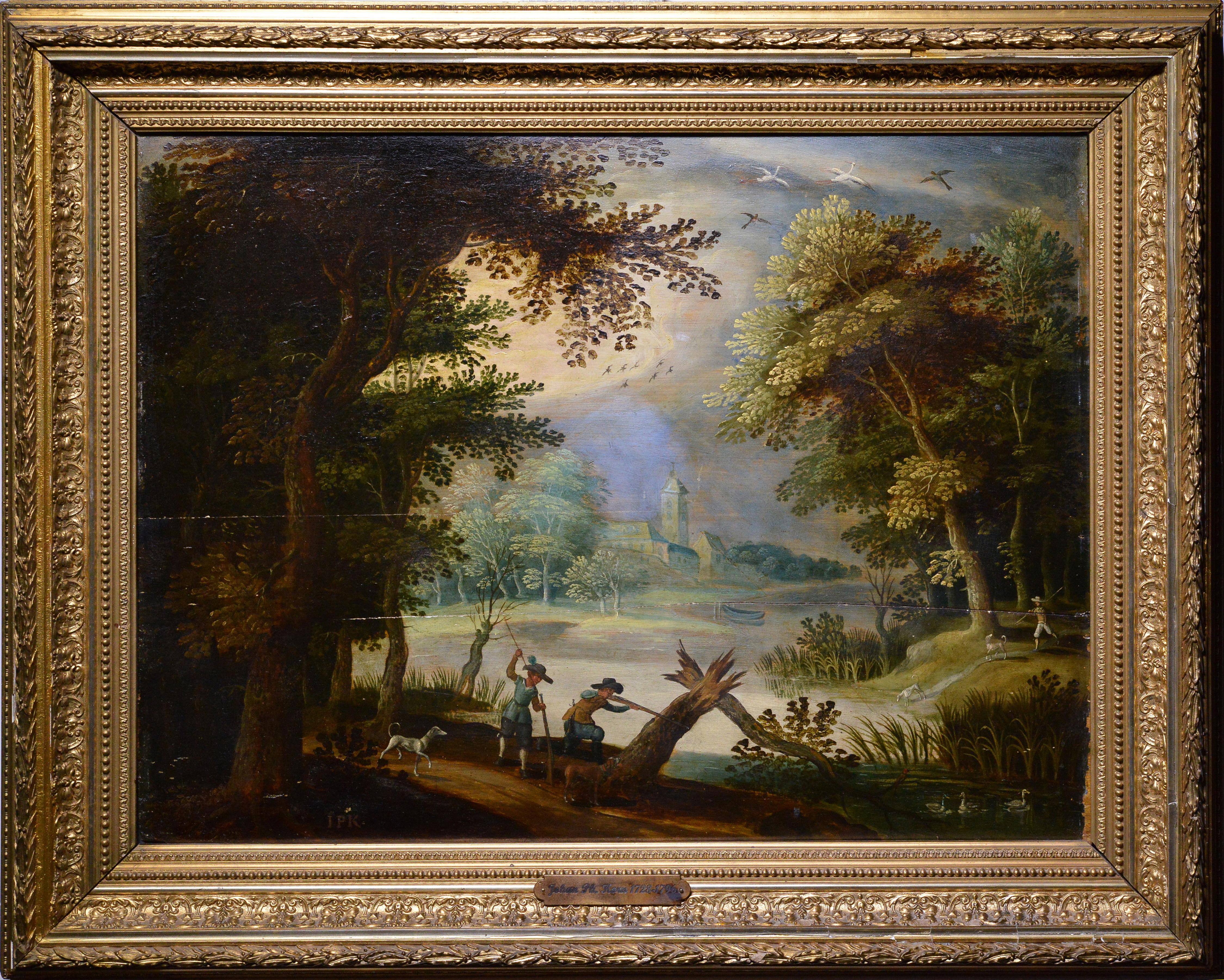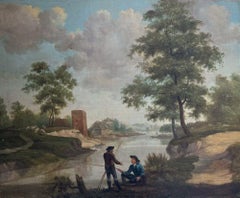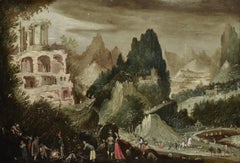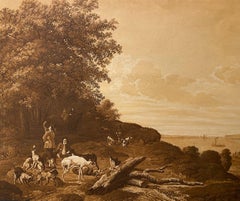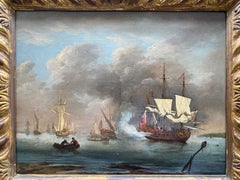Items Similar to Heron Shoot in a Landscape
Want more images or videos?
Request additional images or videos from the seller
1 of 7
Joris Abrahamsz van der HaagenHeron Shoot in a Landscape
$26,867.41
£19,500
€22,921.05
CA$37,177.78
A$40,987.66
CHF 21,443.42
MX$502,842.45
NOK 269,930.19
SEK 252,427.41
DKK 171,174.98
About the Item
Joris Abrahamsz van der Haagen
Heron Shoot in a Landscape
1615-1669
Oil on oak panel, signed 'JAH' lower left
Image size: 16 x 21 inches (41 x 53 cm)
Dutch ebonised frame
Provenance
At Heim, Paris, 1960s
In this landscape, a heron shoot is taking place. Amongst the figures, we see a wealthy couple in fine drapery observing a hunter lining up his shot on a newly startled heron. A retriever dog rushes towards the heron, eagerly awaiting the opportunity to return the quarry to the hunter. The couple’s entourage surrounds them, whilst farmers can be seen with their cattle in the background. However, this depiction of a heron shoot is only a minute aspect of this painting, which predominantly focuses on the stunning river landscape. In fact, this painting depicts many different aspects of natural scenery. The river is a prominent feature, with finely detailed lily pads and bulrushes littered along the banks of its silvery water. Van der Haagen’s skill becomes readily apparent with his skilful rendering of the reflections in the water of the trees in the small copse beside the river. Each leaf of each tree is painted in beautiful detail and with colours ranging from luscious greens to autumnal oranges. The third aspect of the landscape is the expansive sky; grey and overcast, with darker clouds in the foreground hinting at the possibility of rain. Van der Haagen’s artistic ability is undeniable; he has painted three incredibly different natural formations and merged them all into one beautiful artwork.Whilst the events of the hunt in the foreground provide an interesting narrative to the painting, the role of nature is what dominates within the artwork, almost serving as a reminder of the all consuming beauty and power of the natural world in comparison to the whims and pastimes of humanity.
Joris Abrahamsz van der Haagen
Joris Abrahamsz van der Haagen was born in Arnhem in 1615 and was taught how to paint by his father Abraham van der Haagen, who was also an artist. Joris’ career began in a studio in Arnhem, but he relocated to The Hague in 1639 upon the death of his father and eventually became an honorary citizen there.In The Hague, Joris aimed to capitalise on the patronage stemming from the courts situated there, and became a member of the Guild of Saint Luke in 1643. However, factions began to form in the Guild between craftspeople of different trades, promoting Joris to become a founding member of the Confrerie Pictura - a guild dedicated purely to visual artists.Joris died in the Hague in 1669, with two of his sons continuing his painterly legacy. He is known for his landscapes, such as the one depicted in this particular Duck Shooting scene, as well as topographical drawings of towns and cities in the Netherlands. Joris collaborated with the staffage artist Ludolf de Jongh for his figuration, as he never painted figures himself. Therefore, it is likely that the hunters in this painting were composed by de Jongh, creating a unique story to the production of this painting.
- Creator:Joris Abrahamsz van der Haagen (1615 - 1669, Dutch)
- Dimensions:Height: 16 in (40.64 cm)Width: 21 in (53.34 cm)
- Medium:
- Movement & Style:
- Period:
- Condition:
- Gallery Location:London, GB
- Reference Number:1stDibs: LU52416118752
About the Seller
5.0
Vetted Professional Seller
Every seller passes strict standards for authenticity and reliability
Established in 2007
1stDibs seller since 2014
82 sales on 1stDibs
Typical response time: 3 hours
- ShippingRetrieving quote...Shipping from: London, United Kingdom
- Return Policy
Authenticity Guarantee
In the unlikely event there’s an issue with an item’s authenticity, contact us within 1 year for a full refund. DetailsMoney-Back Guarantee
If your item is not as described, is damaged in transit, or does not arrive, contact us within 7 days for a full refund. Details24-Hour Cancellation
You have a 24-hour grace period in which to reconsider your purchase, with no questions asked.Vetted Professional Sellers
Our world-class sellers must adhere to strict standards for service and quality, maintaining the integrity of our listings.Price-Match Guarantee
If you find that a seller listed the same item for a lower price elsewhere, we’ll match it.Trusted Global Delivery
Our best-in-class carrier network provides specialized shipping options worldwide, including custom delivery.More From This Seller
View AllA Riverside Conversation
Located in London, GB
British School
Oil on Canvas, unsigned
Image Size: 31 inches x 25 3/4 inches (79 x 65.5 cm)
Original gilt frame
Gathered along a riverside are two fishermen turned in conversation, ...
Category
18th Century English School Landscape Paintings
Materials
Oil, Canvas
Landscape with Ruins by the Tivoli Falls
Located in London, GB
Oil on copper
Image size: 15 x 10 1/2 inches (38 x 26.5 cm)
Period style hand made frame
This landscape depicts the area surrounding the Tivoli waterfalls in Italy. Thanks to its proximity in Rome, which lies some 30 km to the Southwest, Tivoli has long been a destination for artists. The Italian landscapists whose work was so coveted by Grand Tourist collectors—Claude, Gaspard Dughet and Salvator Rosa—all sketched there, while the Northern Italianates, including Cornelis van Poelenburgh...
Category
Early 17th Century Landscape Paintings
Materials
Copper
Return from the Hunt, Pen and Ink 17th Century Artwork, Handmade Gilt Frame
Located in London, GB
Pen and ink, brown wash, heightened with white bodycolour
Image size: 9 x 10 1/2 inches (22.75 x 26.75 cm)
Mounted with hand made gilt frame
Lingelbach presents a scene from the end...
Category
17th Century Landscape Drawings and Watercolors
Materials
Paper, Ink
Firing the Salute
By Peter Monamy
Located in London, GB
Oil on canvas
Image size: 19 1/2 x 15 1/2 inches (49 x 39.5 cm)
Original frame
This is a a wonderful marine scene depicting a flotilla of battleships, warships and Admiralty yachts....
Category
Early 18th Century Naturalistic Landscape Paintings
Materials
Canvas, Oil
$9,920
Peasants Playing Bowls Outside an Inn, 17th Century Oil on Oak Old Master
Located in London, GB
Studio of David Teniers the Younger
1610 - 1690
Peasants Playing Bowls Outside an Inn
Oil on oak cradled panel, signed
Image size: 16 ½ x 22 ½ inches
Gilt s...
Category
17th Century Old Masters Figurative Paintings
Materials
Oil
Figures on the Beach at Scheveningen
Located in London, GB
Jan van Goyen
1596-1656
Figures on the Beach at Scheveningen
Oil on panel, monogrammed and dated '1642' lower left
Image size: 13 x 21 ¾ inches (33 x 55.5 cm)
Ebonised Dutch frame
P...
Category
17th Century Paintings
Materials
Oil, Panel
You May Also Like
Wooded Figurative River Landscape - Dutch 17thC Golden Age art oil painting
Located in Hagley, England
This superb 17th century Dutch Golden Age oil painting has been more recently reattributed to Abraham Begeyn by Dr Marijke C. de Kinkelder formerly of the RKD - Netherlands Institute for Art History. Painted circa 1640 it is an Italianate wooded river landscape with drovers and their herd crossing a river with a watchtower beyond. Begeyn was one of the many 17th-century Dutch and Flemish painters to embrace the Italianate style, populating their decidedly non-Dutch, mountainous landscapes with rustic travellers and picturesque ruins bathed in warm, Mediterranean light. It has Begeyn's characteristic brightly lit cattle and grouping of figures, similar to a comparable painting in the Lichtenstein Princely Collections. The brushwork and details are superb. One can see the influence of his teacher Nicholaes Berchem (1620-1683) and the typical golden glow of the Golden Age painters. This is a stunning 17th century Golden Age oil painting and an excellent example of Begeyn's work.
Provenance: With Koetser Gallery, Zurich. Private Collection (Rhine region). Anon. sale, Dorotheum, Vienna, 22 June 2010, lot 357, as by Jacob de Heusch (€18,600).
Anon. sale, Christie's South Kensington,18 November 2015, lot 432, as 'Follower of Nicolaes Berchem'; where purchased by the present owner.
Note: Begeyn was one of the many 17th-century Dutch and Flemish painters to embrace the Italianate style, populating their decidedly non-Dutch, mountainous landscapes with rustic travellers and picturesque ruins bathed in warm, Mediterranean light.
He is thought to have studied under Nicolaes Berchem (1620-1683), a pioneer of this genre of landscape painting, and travelled extensively to Italy, London and later to Germany in 1688, where he lived out his days as court painter to Frederick III, Elector of Brandenburg (later Frederick I, King of Prussia).
The present work was previously thought to be the work of Jacob de Heusch (1656-1701), but has been more recently reattributed to Abraham Begeyn by Dr Marijke C. de Kinkelder formerly of the RKD - Netherlands Institute for Art History.
A comparable scene, which also includes Begeyn's characteristic brightly lit cattle and a similar figure group, was sold at Christie's Amsterdam, 18 November 2015, lot 110. Another can be found in the Liechtenstein Princely Collections (no.GE 290).
Condition. Oil on canvas, image size 21 inches by 18 inches and in good condition.
Frame. Housed in a beautiful gilt frame, 28 inches by 25 inches and in good condition.
Abraham Begeyn (c. 1637 Leiden - 11 June 1697 Berlin), was a Dutch Golden Age painter. Begeyn was born in Leiden. Though perhaps known mostly for his Italianate landscapes and cattle in the manner of Nicolaes Pietersz Berchem, Begyn was a highly skilled painter active in many genres, who travelled widely. According to the RKD, Begeyn's earliest known work is from 1653, though he was first accepted into the Guild of St. Luke in Leiden in 1655. He stopped paying dues in 1667, because he set off for a trip to Italy. He is registered in Rome and Naples from 1659–1660. In the rampjaar or disaster year, of 1672, he is registered in Amsterdam, and after that he lived in London, where he painted at Ham House, Surrey, together with Willem van de Velde the Younger (1633–1707) and Dirck van Bergen...
Category
1640s Old Masters Landscape Paintings
Materials
Oil
Landscape Marina See Van Der Velde Paint Oil on canvas Old master 17th Century
Located in Riva del Garda, IT
Quality work attributed to the painter Peter Van Der Velde (Antwerp 1634 - c.1714)
Coastal view with fortified city and boats (city of Antwerp?)
Oil pa...
Category
17th Century Old Masters Paintings
Materials
Oil
$12,123 Sale Price
35% Off
Richly adorned riverscape, late 17th century, Dutch golden age
Located in DEVENTER, NL
Gerrit Maes (1649-1706 or later), attributed
Richly adorned riverscape
Signed and dated in the mid-frame, presumably 'Maasius F. 1695'
Oil on canvas
Dimensions excl. frame: 58 x 82 ...
Category
Late 17th Century Dutch School Landscape Paintings
Materials
Canvas, Oil
River Landscape Water Michout 17/18th Century Paint Oil on canvas Old master
Located in Riva del Garda, IT
Théobald Michou (Tournai, 1676 – Antwerp, 1765)
River landscape with village
Oil on canvas 62 x 98 Framed 74 x 110 cm
We present this vast and harmonious composition, where ...
Category
17th Century Old Masters Paintings
Materials
Oil
$7,336 Sale Price
20% Off
The Heron by the River: atmospheric 19th Century Naturalist school landscape
Located in Norwich, GB
One wonderful thing about this painting is its light. It’s pitch-perfect: if it were a tad
darker, it would be gloomy; a tad lighter, and it there would be less to discover. The joy ...
Category
1860s Naturalistic Landscape Paintings
Materials
Canvas, Oil
Animal scene Duck hunting with dogs 18th century Swedish Master by Philip Korn
Located in Stockholm, SE
Monogrammed lower left: Johan Philip Korn (1728 - 1796), was a Swedish painter. A beautiful landscape, with a backwater in which carefree ducks swim, hunters and their dogs in passion, in the background you can see a city with a bell tower. Old masters have been depicting animals in their paintings since the Renaissance. In those days, hunting scenes were popular - there is always a share of emotional participation in them. Here it is necessary to understand that in previous centuries people looked at hunting as a means of obtaining food, therefore naturalism dominates in the painting of the old masters. Old oil painting on wooden panel, in a non-original frame of the 19th century.
Size app.: 49 x 64 cm (roughly 19.3 x 25.2 in) and nice golden gesso frame ca 65.5 x 81.5 cm (roughly 25.8 x 32.1 in). Very Good condition, age wear, cracks on a wooden board, minor losses, retouches, cleared and conserved. Please study good resolution images for overall cosmetic condition. In person actual painting may appear darker or brighter than in our pictures, strictly depending on sufficient light in your environment. Weight of app. 6.4 kg is going to measure some 10 kg volume weight packed for shipment.
Johan Philip Korn first began his career as a decorative painter. He was a student of artist Johan Sevenbom (1721-1784). After further studies he changed to landscape painting in the Rococo style of French artist François Boucher (1703–1770) and often after Dutch copper engravings. In 1759, Korn became master of the Stockholm...
Category
18th Century Realist Landscape Paintings
Materials
Wood, Oil
More Ways To Browse
Antique Shooting
Antique Heron
Hunter And Dog
17th Century Oak Panels
Painting 1643
American Regionalism Art
Austin Hill
Australian Oil Painting
Canadian Contemporary Artists
City Skyline Art
Danish Fine Art
Haitian Landscape
Maggy Clarysse
Paddle Boat
Sea Battle
Swedish Impressionist
Texas Longhorn
Venice Oil 19th Century

